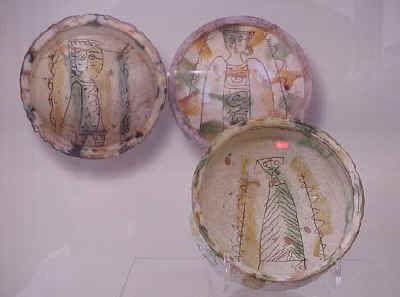 |
 |
 |
| These plank idols are from the early Bronze Age, about 2000 BC. The Bronze Age nearly literally put Cyprus on the map; its name probably derives from the word that means "copper." Copper, a component of bronze, was abundant on the island. Cyprus was a major supplier of copper to Egyptians, Assyrians, Phoenicians, Greeks, and Persians, and was almost the sole source of copper for the Romans. | |
| The chronological table shown at right is in the Pierides Archaeological Museum in Larnaca. The poster shows each historical era with one of the representative objects inside the museum. Note that from the Neolithic Age through the Roman period ending 395 AD, the objects are useful and beautiful and become more sophisticated. Then, during the Byzantine period, 395-1185, or coinciding with some of the medieval period, the object is a simple oil lamp, not very different from those you'd see in a Bronze Age display. It seems to demonstrate the lack of progress in a civilization over hundreds of years. It seems an apt metaphor that the flicker of a light is a reminder of how dark the Dark Ages probably were. |  |
| Mosaics are preserved in many places in Cyprus.
This one, called "The Four Seasons", is in the town of Paphos. This ancient
Roman residence, with thirty-four rooms, was discovered by accident in 1962.
It's called the House of Dionysus, referring to the many mosaics featuring
the god of wine.
The mosaics are still in place in spite of the efforts of the once-US consul to Cyprus, a man named Luigi Palma di Cesnola. He removed about 35,000 artifacts from 70,000 tombs, and many of these now reside in the New York Metropolitan Museum, of which he himself was director some years later. |
|
| These bronze cauldrons were
discovered in the royal necropolis (tombs) at Salamis, an ancient city we
visited when we were in the northern part of the island.
The larger, decorated with sirens and griffins, was in a tomb dating from the eighth century BC. The smaller one has two handles and is decorated with bulls and the head of the ancient Egyptian goddess Hathor, whose domain included the sky, women, fertility and love. |
|
 |
These sgraffito plates were created during the
Venetian rule of 1472-1570. Sgraffito means "scratched" and the designs are
made by painting a color on the plate and then scratching the design through
a contrasting color.
The primitive designs are similar to some of the most modern art, or even cartoons. One of the plates we saw looked like a portrait of Wilma Flintstone. Maybe it was; she lived in Bedrock before the fifteenth century, after all. |